HLSC647 Assignment 1: Summary of Qualitative Research Methods
VerifiedAdded on 2023/01/19
|6
|1469
|99
Homework Assignment
AI Summary
This assignment presents a comprehensive summary of a student's learning journey in a quantitative research methods course (HLSC647), covering the first four weeks of study. Week one focuses on the research process, research designs, and different types of studies, including descriptive, explorative, explanatory, and predictive studies. Week two delves into epidemiology, explaining the occurrence of diseases in populations, factors influencing disease, and key terminologies like prevalence and incidence. Week three explores the relationship between variables, various quantitative study designs (observational and experimental), and measures of association. Finally, week four introduces evidence-based practice (EBP), experimental designs, and ethical considerations in research. The assignment demonstrates an understanding of statistical terminology and concepts within each week's topics, using the provided materials and recommended readings to synthesize the core information.
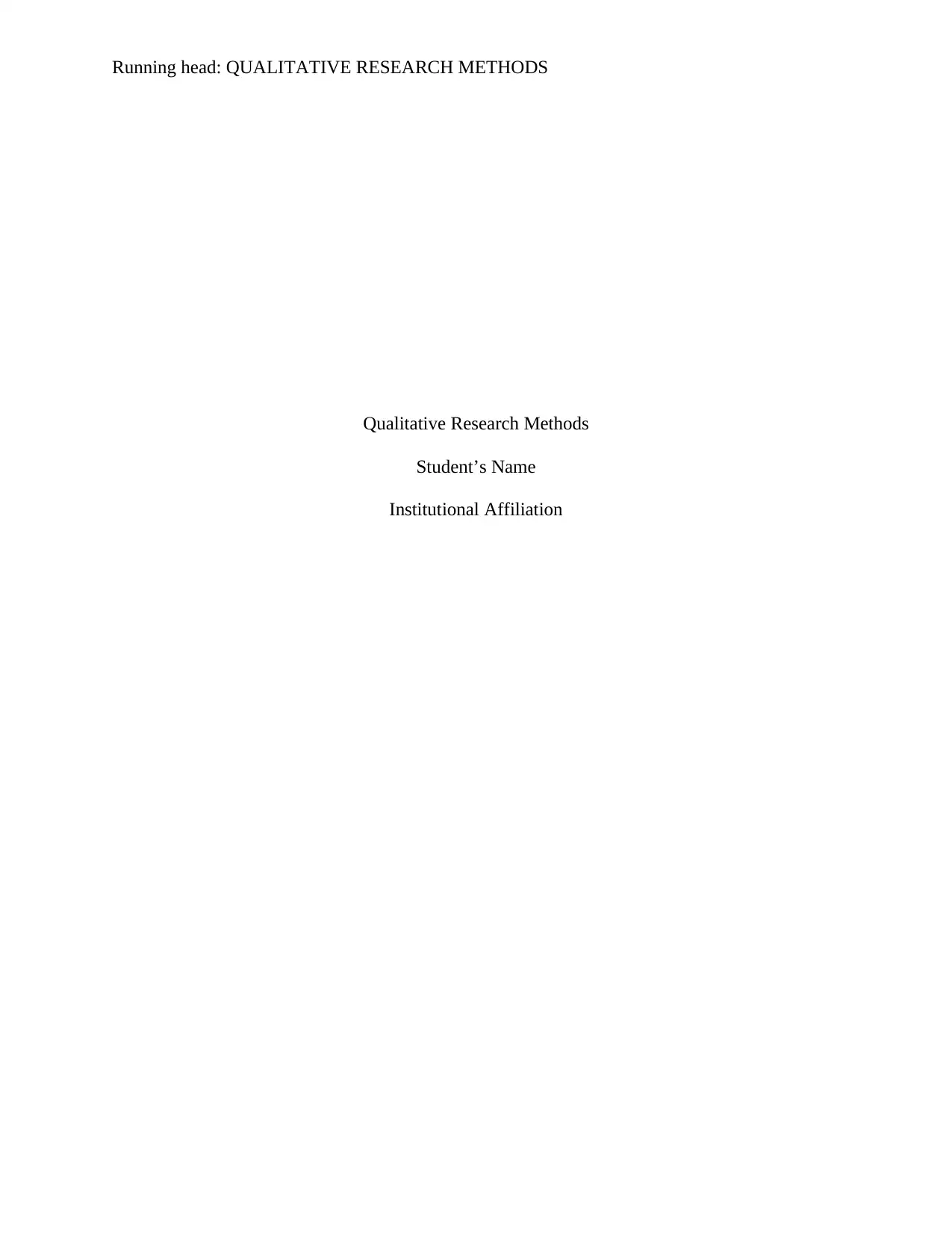
Running head: QUALITATIVE RESEARCH METHODS
Qualitative Research Methods
Student’s Name
Institutional Affiliation
Qualitative Research Methods
Student’s Name
Institutional Affiliation
Paraphrase This Document
Need a fresh take? Get an instant paraphrase of this document with our AI Paraphraser
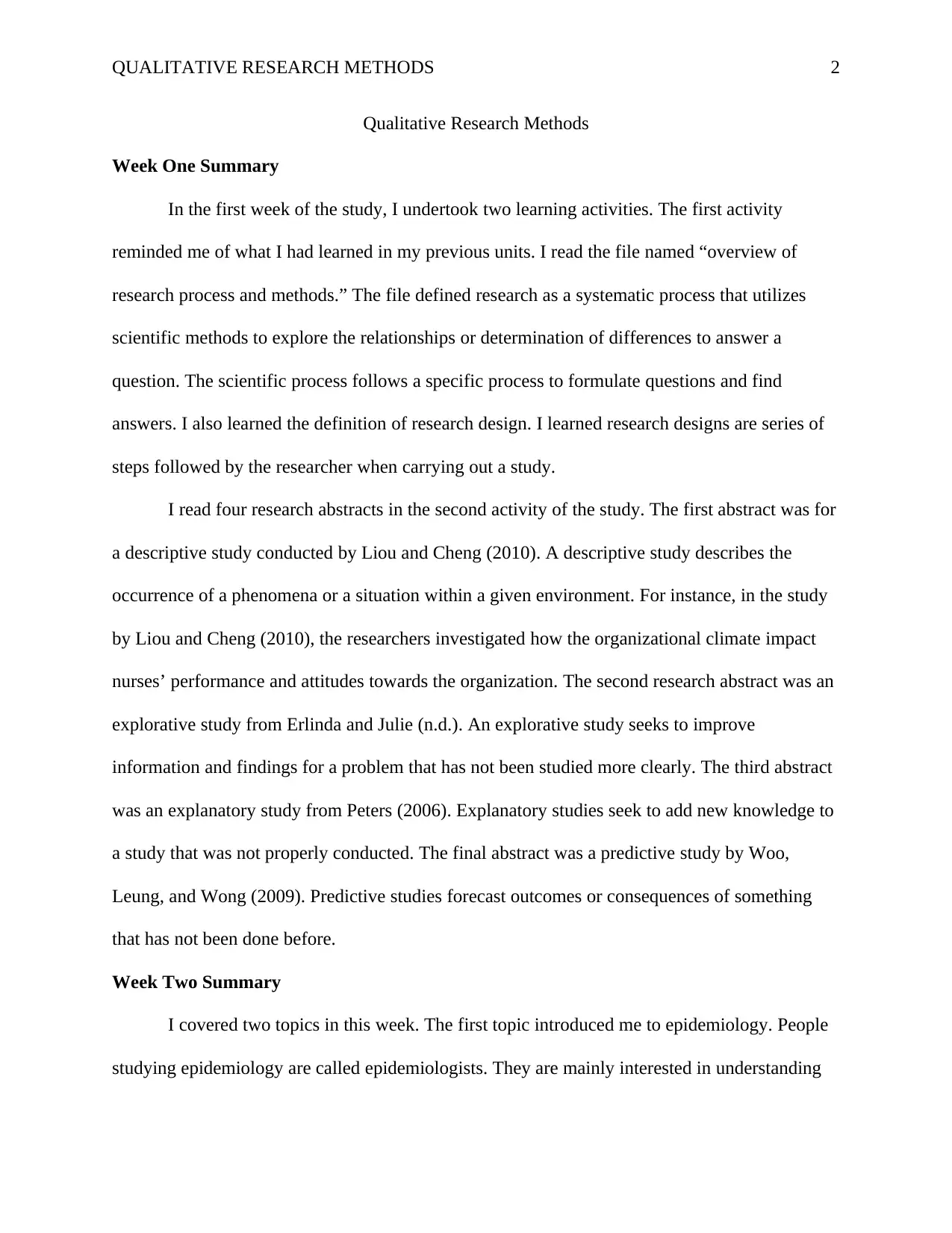
QUALITATIVE RESEARCH METHODS 2
Qualitative Research Methods
Week One Summary
In the first week of the study, I undertook two learning activities. The first activity
reminded me of what I had learned in my previous units. I read the file named “overview of
research process and methods.” The file defined research as a systematic process that utilizes
scientific methods to explore the relationships or determination of differences to answer a
question. The scientific process follows a specific process to formulate questions and find
answers. I also learned the definition of research design. I learned research designs are series of
steps followed by the researcher when carrying out a study.
I read four research abstracts in the second activity of the study. The first abstract was for
a descriptive study conducted by Liou and Cheng (2010). A descriptive study describes the
occurrence of a phenomena or a situation within a given environment. For instance, in the study
by Liou and Cheng (2010), the researchers investigated how the organizational climate impact
nurses’ performance and attitudes towards the organization. The second research abstract was an
explorative study from Erlinda and Julie (n.d.). An explorative study seeks to improve
information and findings for a problem that has not been studied more clearly. The third abstract
was an explanatory study from Peters (2006). Explanatory studies seek to add new knowledge to
a study that was not properly conducted. The final abstract was a predictive study by Woo,
Leung, and Wong (2009). Predictive studies forecast outcomes or consequences of something
that has not been done before.
Week Two Summary
I covered two topics in this week. The first topic introduced me to epidemiology. People
studying epidemiology are called epidemiologists. They are mainly interested in understanding
Qualitative Research Methods
Week One Summary
In the first week of the study, I undertook two learning activities. The first activity
reminded me of what I had learned in my previous units. I read the file named “overview of
research process and methods.” The file defined research as a systematic process that utilizes
scientific methods to explore the relationships or determination of differences to answer a
question. The scientific process follows a specific process to formulate questions and find
answers. I also learned the definition of research design. I learned research designs are series of
steps followed by the researcher when carrying out a study.
I read four research abstracts in the second activity of the study. The first abstract was for
a descriptive study conducted by Liou and Cheng (2010). A descriptive study describes the
occurrence of a phenomena or a situation within a given environment. For instance, in the study
by Liou and Cheng (2010), the researchers investigated how the organizational climate impact
nurses’ performance and attitudes towards the organization. The second research abstract was an
explorative study from Erlinda and Julie (n.d.). An explorative study seeks to improve
information and findings for a problem that has not been studied more clearly. The third abstract
was an explanatory study from Peters (2006). Explanatory studies seek to add new knowledge to
a study that was not properly conducted. The final abstract was a predictive study by Woo,
Leung, and Wong (2009). Predictive studies forecast outcomes or consequences of something
that has not been done before.
Week Two Summary
I covered two topics in this week. The first topic introduced me to epidemiology. People
studying epidemiology are called epidemiologists. They are mainly interested in understanding
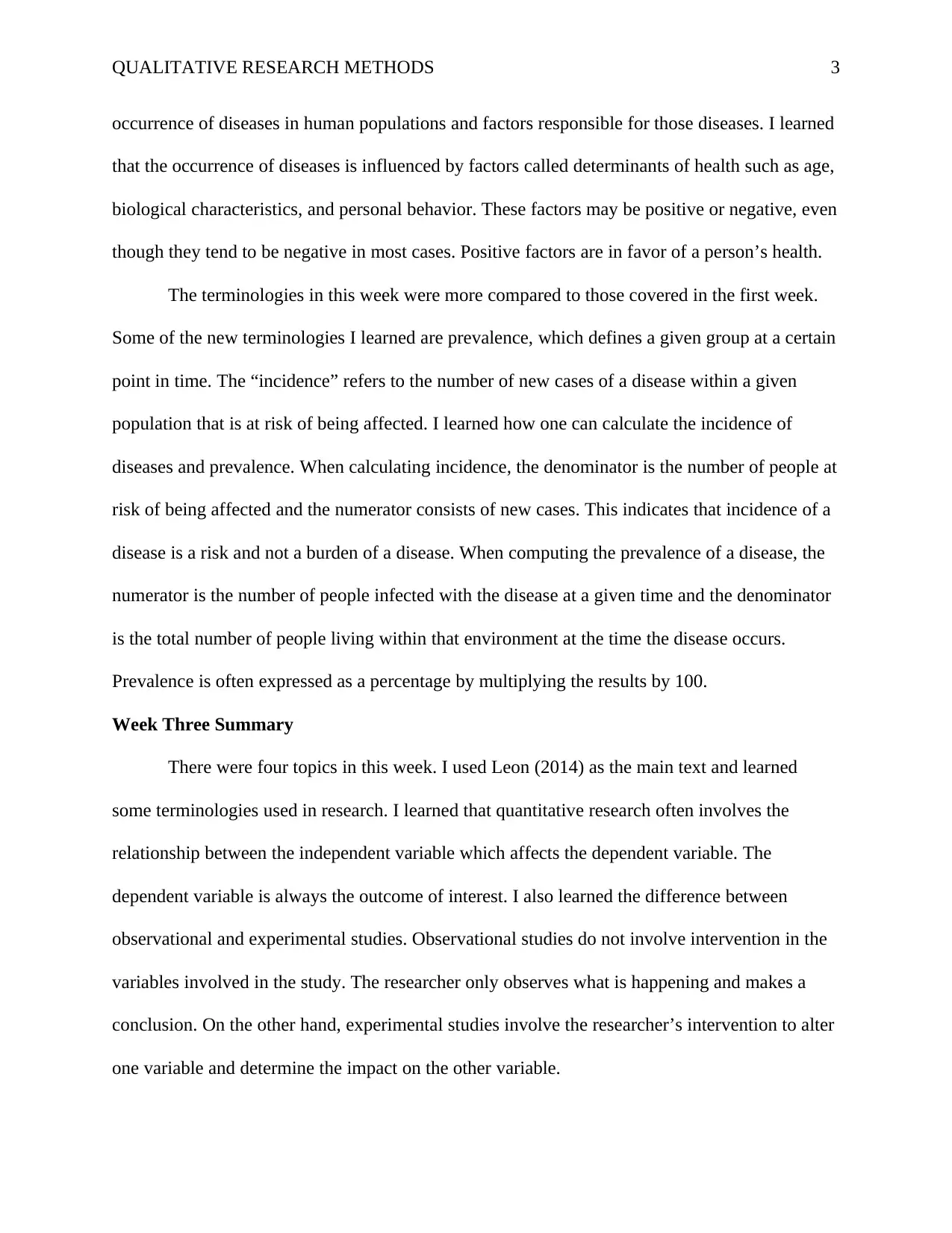
QUALITATIVE RESEARCH METHODS 3
occurrence of diseases in human populations and factors responsible for those diseases. I learned
that the occurrence of diseases is influenced by factors called determinants of health such as age,
biological characteristics, and personal behavior. These factors may be positive or negative, even
though they tend to be negative in most cases. Positive factors are in favor of a person’s health.
The terminologies in this week were more compared to those covered in the first week.
Some of the new terminologies I learned are prevalence, which defines a given group at a certain
point in time. The “incidence” refers to the number of new cases of a disease within a given
population that is at risk of being affected. I learned how one can calculate the incidence of
diseases and prevalence. When calculating incidence, the denominator is the number of people at
risk of being affected and the numerator consists of new cases. This indicates that incidence of a
disease is a risk and not a burden of a disease. When computing the prevalence of a disease, the
numerator is the number of people infected with the disease at a given time and the denominator
is the total number of people living within that environment at the time the disease occurs.
Prevalence is often expressed as a percentage by multiplying the results by 100.
Week Three Summary
There were four topics in this week. I used Leon (2014) as the main text and learned
some terminologies used in research. I learned that quantitative research often involves the
relationship between the independent variable which affects the dependent variable. The
dependent variable is always the outcome of interest. I also learned the difference between
observational and experimental studies. Observational studies do not involve intervention in the
variables involved in the study. The researcher only observes what is happening and makes a
conclusion. On the other hand, experimental studies involve the researcher’s intervention to alter
one variable and determine the impact on the other variable.
occurrence of diseases in human populations and factors responsible for those diseases. I learned
that the occurrence of diseases is influenced by factors called determinants of health such as age,
biological characteristics, and personal behavior. These factors may be positive or negative, even
though they tend to be negative in most cases. Positive factors are in favor of a person’s health.
The terminologies in this week were more compared to those covered in the first week.
Some of the new terminologies I learned are prevalence, which defines a given group at a certain
point in time. The “incidence” refers to the number of new cases of a disease within a given
population that is at risk of being affected. I learned how one can calculate the incidence of
diseases and prevalence. When calculating incidence, the denominator is the number of people at
risk of being affected and the numerator consists of new cases. This indicates that incidence of a
disease is a risk and not a burden of a disease. When computing the prevalence of a disease, the
numerator is the number of people infected with the disease at a given time and the denominator
is the total number of people living within that environment at the time the disease occurs.
Prevalence is often expressed as a percentage by multiplying the results by 100.
Week Three Summary
There were four topics in this week. I used Leon (2014) as the main text and learned
some terminologies used in research. I learned that quantitative research often involves the
relationship between the independent variable which affects the dependent variable. The
dependent variable is always the outcome of interest. I also learned the difference between
observational and experimental studies. Observational studies do not involve intervention in the
variables involved in the study. The researcher only observes what is happening and makes a
conclusion. On the other hand, experimental studies involve the researcher’s intervention to alter
one variable and determine the impact on the other variable.
⊘ This is a preview!⊘
Do you want full access?
Subscribe today to unlock all pages.

Trusted by 1+ million students worldwide
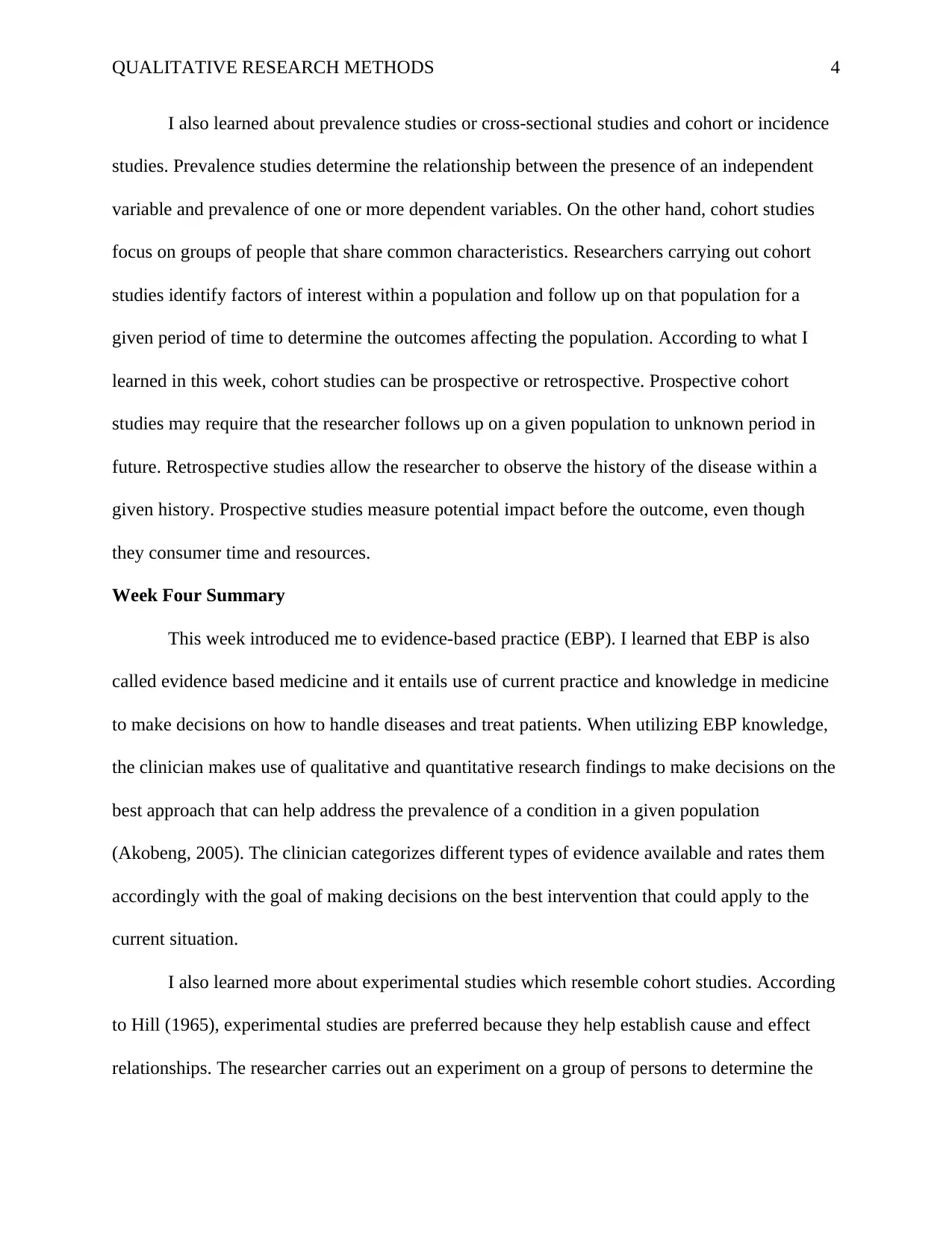
QUALITATIVE RESEARCH METHODS 4
I also learned about prevalence studies or cross-sectional studies and cohort or incidence
studies. Prevalence studies determine the relationship between the presence of an independent
variable and prevalence of one or more dependent variables. On the other hand, cohort studies
focus on groups of people that share common characteristics. Researchers carrying out cohort
studies identify factors of interest within a population and follow up on that population for a
given period of time to determine the outcomes affecting the population. According to what I
learned in this week, cohort studies can be prospective or retrospective. Prospective cohort
studies may require that the researcher follows up on a given population to unknown period in
future. Retrospective studies allow the researcher to observe the history of the disease within a
given history. Prospective studies measure potential impact before the outcome, even though
they consumer time and resources.
Week Four Summary
This week introduced me to evidence-based practice (EBP). I learned that EBP is also
called evidence based medicine and it entails use of current practice and knowledge in medicine
to make decisions on how to handle diseases and treat patients. When utilizing EBP knowledge,
the clinician makes use of qualitative and quantitative research findings to make decisions on the
best approach that can help address the prevalence of a condition in a given population
(Akobeng, 2005). The clinician categorizes different types of evidence available and rates them
accordingly with the goal of making decisions on the best intervention that could apply to the
current situation.
I also learned more about experimental studies which resemble cohort studies. According
to Hill (1965), experimental studies are preferred because they help establish cause and effect
relationships. The researcher carries out an experiment on a group of persons to determine the
I also learned about prevalence studies or cross-sectional studies and cohort or incidence
studies. Prevalence studies determine the relationship between the presence of an independent
variable and prevalence of one or more dependent variables. On the other hand, cohort studies
focus on groups of people that share common characteristics. Researchers carrying out cohort
studies identify factors of interest within a population and follow up on that population for a
given period of time to determine the outcomes affecting the population. According to what I
learned in this week, cohort studies can be prospective or retrospective. Prospective cohort
studies may require that the researcher follows up on a given population to unknown period in
future. Retrospective studies allow the researcher to observe the history of the disease within a
given history. Prospective studies measure potential impact before the outcome, even though
they consumer time and resources.
Week Four Summary
This week introduced me to evidence-based practice (EBP). I learned that EBP is also
called evidence based medicine and it entails use of current practice and knowledge in medicine
to make decisions on how to handle diseases and treat patients. When utilizing EBP knowledge,
the clinician makes use of qualitative and quantitative research findings to make decisions on the
best approach that can help address the prevalence of a condition in a given population
(Akobeng, 2005). The clinician categorizes different types of evidence available and rates them
accordingly with the goal of making decisions on the best intervention that could apply to the
current situation.
I also learned more about experimental studies which resemble cohort studies. According
to Hill (1965), experimental studies are preferred because they help establish cause and effect
relationships. The researcher carries out an experiment on a group of persons to determine the
Paraphrase This Document
Need a fresh take? Get an instant paraphrase of this document with our AI Paraphraser
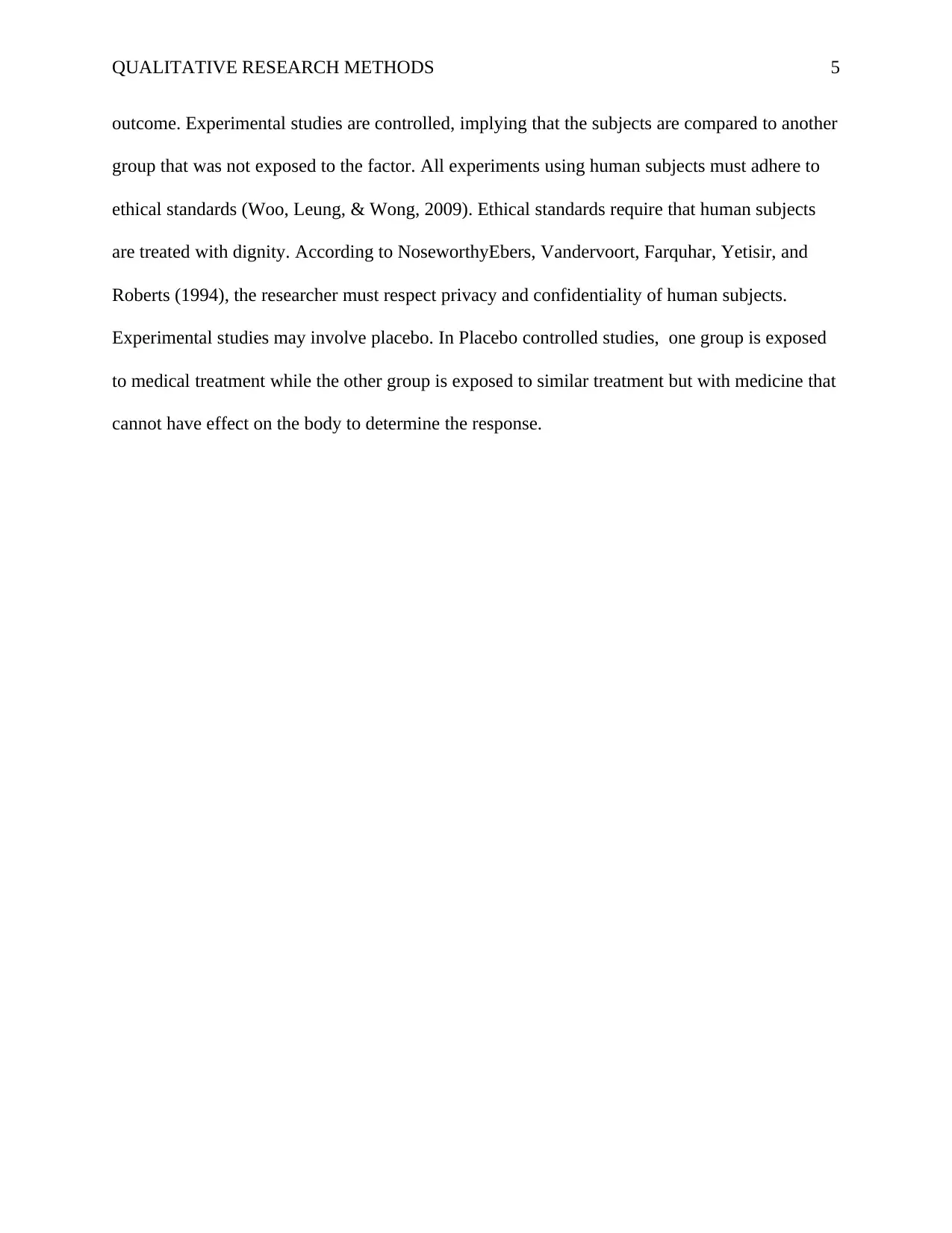
QUALITATIVE RESEARCH METHODS 5
outcome. Experimental studies are controlled, implying that the subjects are compared to another
group that was not exposed to the factor. All experiments using human subjects must adhere to
ethical standards (Woo, Leung, & Wong, 2009). Ethical standards require that human subjects
are treated with dignity. According to NoseworthyEbers, Vandervoort, Farquhar, Yetisir, and
Roberts (1994), the researcher must respect privacy and confidentiality of human subjects.
Experimental studies may involve placebo. In Placebo controlled studies, one group is exposed
to medical treatment while the other group is exposed to similar treatment but with medicine that
cannot have effect on the body to determine the response.
outcome. Experimental studies are controlled, implying that the subjects are compared to another
group that was not exposed to the factor. All experiments using human subjects must adhere to
ethical standards (Woo, Leung, & Wong, 2009). Ethical standards require that human subjects
are treated with dignity. According to NoseworthyEbers, Vandervoort, Farquhar, Yetisir, and
Roberts (1994), the researcher must respect privacy and confidentiality of human subjects.
Experimental studies may involve placebo. In Placebo controlled studies, one group is exposed
to medical treatment while the other group is exposed to similar treatment but with medicine that
cannot have effect on the body to determine the response.
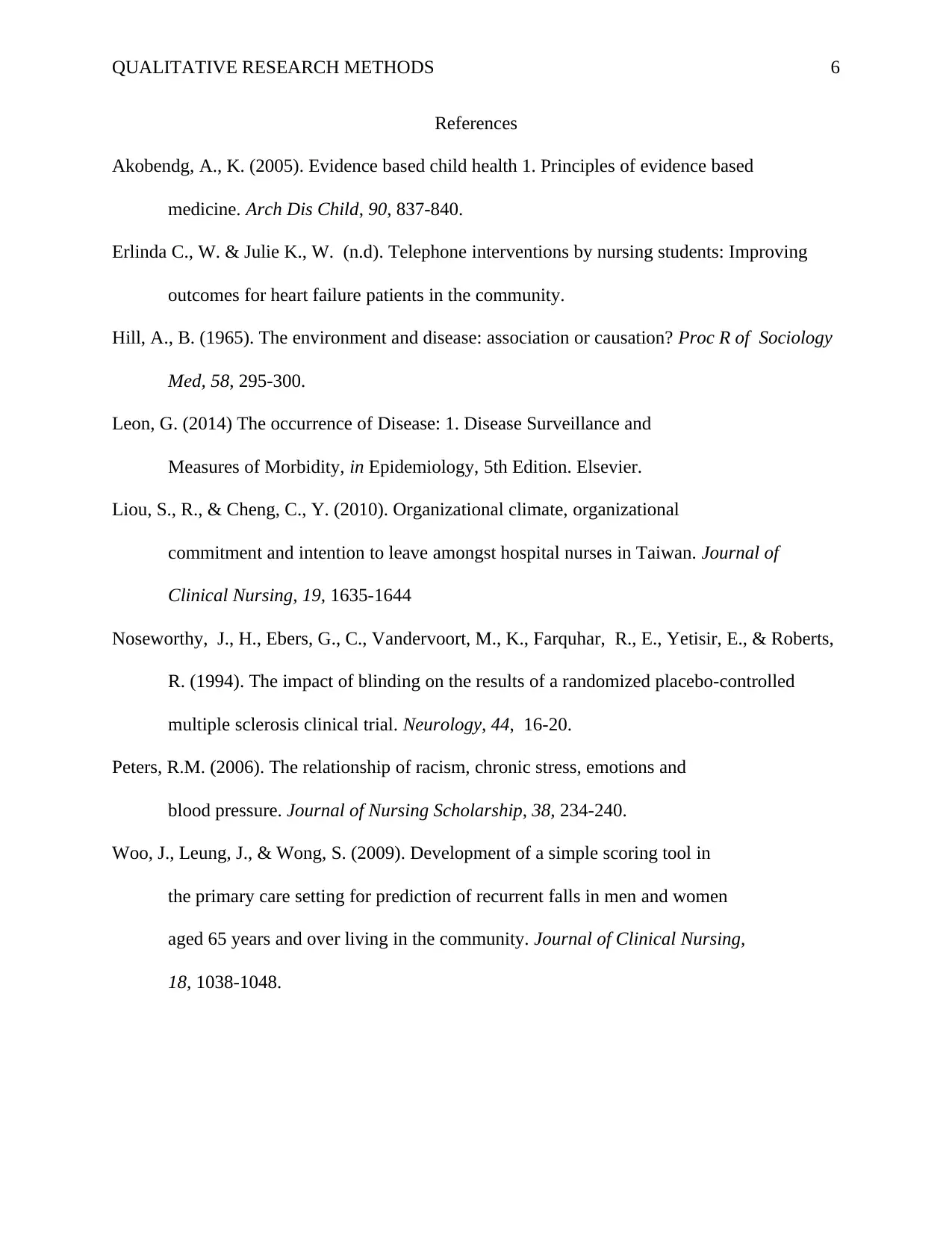
QUALITATIVE RESEARCH METHODS 6
References
Akobendg, A., K. (2005). Evidence based child health 1. Principles of evidence based
medicine. Arch Dis Child, 90, 837-840.
Erlinda C., W. & Julie K., W. (n.d). Telephone interventions by nursing students: Improving
outcomes for heart failure patients in the community.
Hill, A., B. (1965). The environment and disease: association or causation? Proc R of Sociology
Med, 58, 295-300.
Leon, G. (2014) The occurrence of Disease: 1. Disease Surveillance and
Measures of Morbidity, in Epidemiology, 5th Edition. Elsevier.
Liou, S., R., & Cheng, C., Y. (2010). Organizational climate, organizational
commitment and intention to leave amongst hospital nurses in Taiwan. Journal of
Clinical Nursing, 19, 1635-1644
Noseworthy, J., H., Ebers, G., C., Vandervoort, M., K., Farquhar, R., E., Yetisir, E., & Roberts,
R. (1994). The impact of blinding on the results of a randomized placebo-controlled
multiple sclerosis clinical trial. Neurology, 44, 16-20.
Peters, R.M. (2006). The relationship of racism, chronic stress, emotions and
blood pressure. Journal of Nursing Scholarship, 38, 234-240.
Woo, J., Leung, J., & Wong, S. (2009). Development of a simple scoring tool in
the primary care setting for prediction of recurrent falls in men and women
aged 65 years and over living in the community. Journal of Clinical Nursing,
18, 1038-1048.
References
Akobendg, A., K. (2005). Evidence based child health 1. Principles of evidence based
medicine. Arch Dis Child, 90, 837-840.
Erlinda C., W. & Julie K., W. (n.d). Telephone interventions by nursing students: Improving
outcomes for heart failure patients in the community.
Hill, A., B. (1965). The environment and disease: association or causation? Proc R of Sociology
Med, 58, 295-300.
Leon, G. (2014) The occurrence of Disease: 1. Disease Surveillance and
Measures of Morbidity, in Epidemiology, 5th Edition. Elsevier.
Liou, S., R., & Cheng, C., Y. (2010). Organizational climate, organizational
commitment and intention to leave amongst hospital nurses in Taiwan. Journal of
Clinical Nursing, 19, 1635-1644
Noseworthy, J., H., Ebers, G., C., Vandervoort, M., K., Farquhar, R., E., Yetisir, E., & Roberts,
R. (1994). The impact of blinding on the results of a randomized placebo-controlled
multiple sclerosis clinical trial. Neurology, 44, 16-20.
Peters, R.M. (2006). The relationship of racism, chronic stress, emotions and
blood pressure. Journal of Nursing Scholarship, 38, 234-240.
Woo, J., Leung, J., & Wong, S. (2009). Development of a simple scoring tool in
the primary care setting for prediction of recurrent falls in men and women
aged 65 years and over living in the community. Journal of Clinical Nursing,
18, 1038-1048.
⊘ This is a preview!⊘
Do you want full access?
Subscribe today to unlock all pages.

Trusted by 1+ million students worldwide
1 out of 6
Your All-in-One AI-Powered Toolkit for Academic Success.
+13062052269
info@desklib.com
Available 24*7 on WhatsApp / Email
![[object Object]](/_next/static/media/star-bottom.7253800d.svg)
Unlock your academic potential
Copyright © 2020–2025 A2Z Services. All Rights Reserved. Developed and managed by ZUCOL.